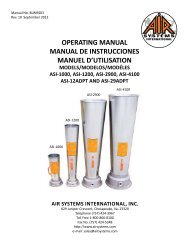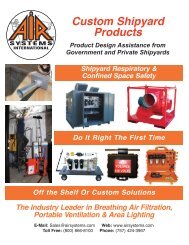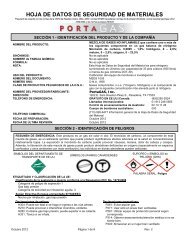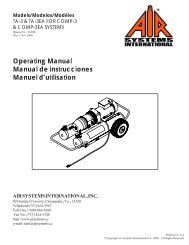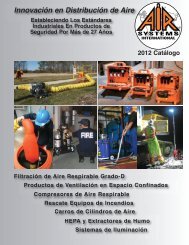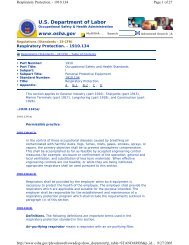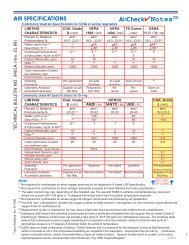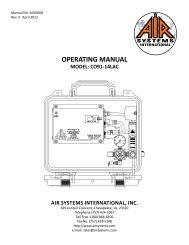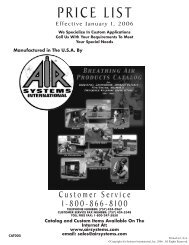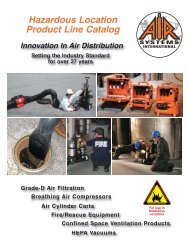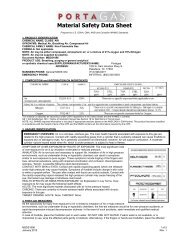MP-TR1 rev 4.pdf - Air Systems International
MP-TR1 rev 4.pdf - Air Systems International
MP-TR1 rev 4.pdf - Air Systems International
You also want an ePaper? Increase the reach of your titles
YUMPU automatically turns print PDFs into web optimized ePapers that Google loves.
-2-OVERVIEWThe model <strong>MP</strong>-<strong>TR1</strong> cart is one in a series of multipurpose (<strong>MP</strong>) bottled air carts. A lowpressure (yellow), under 125psi, as well as a high pressure (blue), under 275psi, regulated airsystem has been installed.The cart’s air source can be either 2 SCBA air cylinders or an auxiliary (external) air source.An isolation valve is supplied to toggle between a common air source and isolating the yellow andblue sides of the air distribution panel.A low pressure whistle alarm is used on the yellow side of the panel and a low pressure bellis used on the blue side of the panel. Both alarms activate if the auxiliary inlet is used as the primaryair supply.Respirator and tool fittings should be specified when ordering. It is recommended that thehigh pressure tool side of the cart have different and unique fittings than those found on the respiratorside. Consult with the tool manufacturer and install their recommended fittings.
-3-SPECIFICATIONSSize (Handle Down):Weight w/o cylinders:Frame:Cylinder Straps:Panel:Whip Assemblies:Bleeder ValvesCheck Valves:Respirator PressureRegulator:High Pressure ToolRegulator:Low PressureTool Regulator:(Located at bottom ofpanel)Relief Valve (Yellow)Setting Side:Relief Valve (Blue)Setting Side:<strong>Air</strong> Distribution:Intrinsically Safe:<strong>Air</strong> Supply:<strong>Air</strong> Supply LowPressure Warning35 H x 20.5"W x 15" D54.5 lbsStainless SteelFour (4) adjustable nylon with velcoStainless steel color coded by air function5000psi (345 bar) rated 4:1 safety factorAllows depressurization of hand tight nutsAllows independent cylinder operation0-5500psi inlet; 0-125psi outletMinimum flow rate: 18.75cfm @ 500psi inlet pressure and 80psi outletMaximum flow rate: 63 cfm @ 5000psi inlet pressure and 100psi outlet0-6000psi inlet; 0-275psi outlet.Minimum flow rate: 18.1 cfm @ 500psi inlet pressure and 80psi outletMaximum flow rate: 162.75 cfm @ 6000psi inlet pressure and0-300psi inlet (inlet pressure set by high pressure tool regulator's outletpressure); 0-125psi outletMinimum flow rate: 5 cfm @ 100psi inlet pressure and 80psi outletMaximum flow rate: 24 cfm @ 275psi inlet pressure and 80psi outlet125psi ASME preset; 116cfm flow rate275psi or 125psi ASME preset relief valves manually selected bypneumatic toggle. 241/140 cfm flow rate respectivelyFour (4) respirator Quick Connect SocketsFour (4) High Pressure Tool Quick Connect SocketsOne (1) Low Pressure Tool Quick Connect SocketNo electronic devicesTwo cylinders (2216psi or 4500 psi rated). Auxiliary high pressure inlet(CGA-347 male with pressure cap)Onboard cylinders, pneumatic whistle set at approximately 500psi.Auxiliary inlet, pneumatic bell set at 500psi
-4-GENERAL SETUPSTEP 1)Install SCBA cylinders on cart. Position the valves as shown on the drawing (Page 5). Securecylinders by tightening the straps at the buckle and mate the velcro sections to p<strong>rev</strong>ent slipping.2216psi (153 bar) cylinders or 4500psi (310 bar) cylinders will fit on the cart.STEP 2)Install universal CGA-347 hand tight nuts to the cylinder valves and tighten.STEP 3)Insure both bleeder valves are closed by turning fully clockwise.STEP 4)Index the air source selector valve to the “<strong>Air</strong> Source Common” position (horizontal).WARNING: Regulators should be off before opening cylinders . Adjust the regulatorknob fully counterclockwise. Damage can occur from inital shock to the system if theregulators are set near maximum pressure.STEP 5)Open cylinder #1 (one). At this time the low pressure warning whistle and bell will sound until theyset at approximately 1000psi (69 bar). Close the cylinder.STEP 6)Check reading on gauge to verify cylinder is full.STEP 7)Set the required respirator pressure with the “Respirator Pressure Regulator” control knob located onthe yellow panel side.STEP 8)Bleed system pressure by partially engaging a male plug into one of the respirator couplings. Thisdepressurizes the manifold and simulates low cylinder pressure. The low pressure warning whistleand bell will sound at approximately 500psi (35 bar). After confirming the warning signals, reinsertmale plug and drain completely.STEP 9)Open cylinder #2 (two). At this time the low pressure warning whistle and bell will resound untilthey set at approximately 1000psi (69 bar). Repeat Steps 5 and 6 for cylinder #2 (two).Proceed to a specific setup, see:Page 6 - “Simultaneous operation of respirators and high pressure tools”Page 8 - “Isolating two respiratory systems”Note: Once work application is complete, proceed to Shut Down procedure (Page 10).
-5-GENERAL SETUPFollow Steps 1-9 on Page 4AIR SOURCES ISOLATEDAIR SOURCES COMMON
-6-SIMULTANEOUS OPERATION OF RESPIRATORS &HIGH PRESSURE TOOLSSTEP 1) Position the pneumatic toggle valve in the “Tool <strong>Air</strong> Relief” position. (Right facing panel).WARNING: Regulators should be off before opening cylinders . Adjust the regulator knob fully counterclockwise.Damage can occur from inital shock to the system if the regulators are set near maximum pressure.STEP 2) Open one cylinder valve. (Cylinder #2 two should still be open from General Setup).I<strong>MP</strong>ORTANT USAGE NOTE:When the cylinder in use has been depleted to approximately 500psi (35 bar), the low pressure warning alarm willsound indicating that the cylinder needs to be replaced.To change a cylinder while the cart is still in use:1) Open the second cylinder and note the gauge pressure to assure that it is full.2) Close the drained cylinder and open the corresponding bleeder valve to relieve pressure on the hand tight nut.3) Remove the drained cylinder and install a full cylinder in its place. Connect the CGA-347 hand tight nut tothe cylinder valve. Close the bleeder valve on the connect whip, it is now ready for use when the othercylinder pressure descends to 500psi or lower.Note: The system is equipped with check valves that will p<strong>rev</strong>ent back flow from the other cylinder in use.STEP 3) Turn the air source valve towards the “<strong>Air</strong> Source Common” position (horizontal).YELLOW AIR DISTRIBUTION SETUPSTEP 4) Set the required respirator pressure with the “Respirator Pressure Regulator”.STEP 5) Couple respirators and lengths of hoses to the manifold. If necessary, make any final pressure adjustments.The “Yellow <strong>Air</strong> Distribution” supply system is now operational.BLUE AIR TOOL DISTRIBUTION SETUPSTEP 6) Set the high pressure tool regulator to satisfy the device with the highest pressure requirement. Maximum outletpressure is 275psi. The pressure relief valve does have a +/- 10% variance which my effect the maximum output pressure.STEP 7) Connect tool(s) and lengths of hoses to the “Blue” manifold. If necessary, make any final pressure adjustments.The “Blue <strong>Air</strong> Tool” distribution supply system is now operational.STEP 8) Set the low pressure tool regulator pressure to satisfy the device with the lowest pressure requirement. Maximumoutlet pressure is 125psi. The low pressure regulator’s air supply comes through the high pressure tool regulator,therefore, the high pressure tool regulator’s set pressure must be equal to or greater than the desired set pressure of thelow pressure tool regulator.I<strong>MP</strong>ORTANT USAGE NOTICE :Due to the high air consumption rate of pneumatic tools an auxiliary air source should be used. If an auxiliary supplyis not going to be used, omit Steps 9 and 10 of this procedure.AUXILIARY HIGH PRESSURE INLET SETUPSTEP 9) Connect the auxiliary air source to the “Auxiliary High Pressure Inlet”; the inlet adapter is a CGA-347 male nutwith a pressure cap. Open the auxiliary air source.STEP 10) Turn the air source valve towards the “<strong>Air</strong> Sources Isolated” position (vertical).Note: Cylinders #1 and #2 are now dedicated to the “Yellow” distribution side. The“Auxiliary High Pressure” is now dedicated to the “Blue” distribution side.
ISOLATING TWO RESPIRATOR SYSTEMSSTEP 1) Position the pneumatic toggle valve in the “Respirator <strong>Air</strong> Relief” position. (Left,facing panel).STEP 2) Turn the air source valve towards the “<strong>Air</strong> Sources Isolated” position (vertical).-8-STEP 3) Open cylinder #1 or cylinder #2.Note: Open only one cylinder if the other cylinder is to be used for backup or reserve.STEP 4) Connect the third air source to the “Auxiliary High Pressure Inlet”. The inlet adapter isa CGA-347 male nut with a pressure cap.YELLOW AIR DISTRIBUTION SETUPSTEP 5) Set the required respirator pressure with the “Respirator Pressure Regulator”.STEP 6) Couple respirators and lengths of hoses to the yellow manifold. If necessary, make anyfinal pressure adjustments. The “Yellow <strong>Air</strong> Distribution” supply system is now operational.BLUE AIR DISTRIBUTION SETUPSTEP 7) Set the required respirator pressure with the “High Pressure Tool Regulator”.STEP 8) Install optional “tool-to-respirator-fitting-adapters” into tool side couplings; then installrespirators and lengths of hoses to the “Blue” manifold. If necessary, make any final pressureadjustments. The “Blue <strong>Air</strong> Tool” distribution supply system is now operational.Note: This operation satisfies NFPA’s recommended general practices for isolated/independentair sources and delivery systems for both primary and backup rescue teams when operated in thiscondition. In the event of only one supply source available, or one of the two supply sources becomedepleted and not replenishable, the air source valve (Step 2) can be indexed to “<strong>Air</strong> SourcesCommon” position. This will supply both sides with a supply of high pressure air from either ofthe sources that are still of sufficient pressure. This does not meet the above NFPA’s recommendedpractices but will allow for the safe evacuation of all personnel.
SHUTDOWNMake sure all personnel have egressed the hazardous area and have disconnected from thebreathing air system.-10-1) Close cylinder valves.2) Depressurize manifolds by venting one of the quick connect couplings on each manifold.3) Close the regulator(s) by turning the control knob counterclockwise.4) Disconnect airline hoses and reinstall dust caps.5) Remove whip connections from cylinders and reinstall cylinder valve covers(if applicable).HIGH PRESSURE AIRLINE GENERAL MAINTENANCE & INSPECTIONMonthly1. Check regulators, gauges, and valves for external leakage.2. Inspect cylinder valves for proper closure.3. Check cylinder pigtails for cleanliness, flexibility, wear, leakage, blisters on hose, threaddamage, and O-rings on CGA fittings. Replace damaged items immediately.Annually1. Check relief valve's pressure setting.2. Check regulator function by opening and closing regulator valve knob fully.3. Check the last hydrostatic test date of all cylinders and retest at required DOT intervals.Every 4 years1. Replace all flexible pigtails - consult factory.
-11-REPLACEMENT ITEMS/PARTS IDENTIFICATIONITEM # DESCRIPTION PART #1 8" WHEEL HDWR1002 NY LON CY LINDER STRA P HDWR113A3 PULL PIN FOR HOSE BRA CKET HDWR1304 PULL PIN FOR HA NDLE HDWR1145 CGA -347 HA ND-TIGHT NUT/NIPPLE SS347HT6 BLEEDER VALVE VAL0307 CGA-347 MALE ADAPTER SS4F347AM8 CGA -347 PRESSURE CA P SS347CA P9 A UXILIA RY INLET LOW PRESSURE BELL A C-PA 25B10 ONBOA RD CY LINDER LOW PRESSURE WHISTLE A C-PA 2511 A IR SUPPLY/DISTRIBUTION ISOLATION V A LV E V A L07312 RESPIRA TOR REGULA TOR INLET PRESSURE GA UGE GA 2075KB13 HIGH PRESSURE TOOL REGULA TOR INLET PRESSURE GA UGE GA 2075KB14 RESPIRA TOR PRESSURE REGULATOR REG00415 HIGH PRESSURE TOOL PRESSURE REGULA TOR REG00816 RESPIRA TOR SET PRESSURE GA UGE GA 20160B17 HIGH PRESSURE TOOL SET PRESSURE GA UGE GA 20300B18 LOW PRESSURE TOOL PRESSURE REGULA TOR WL01319 LOW PRESSURE TOOL SET PRESSURE GA UGE GA 15160B20 2 WAY TOGGLE SWITCH FOR RELIEF VALVES PSVLV095
-12-QUICK FILL OPTION FOR TECH-RESCUE CARTORDER PART NUMBER QFH-5<strong>MP</strong><strong>TR1</strong>Installing the Quick-Fill option on the Tech-Rescue Cart can be done with the initial purchase of thecart by ordering the part number QFH-5<strong>MP</strong><strong>TR1</strong> at the time of order. This option can also be installedat the factory as a retrofit by contacting our Repair Servicedepartment or an inside sales associate.Useage Instruction1) Install Hose The Quick-fill hose allows the user to rapidly fill an approved SCBA withthe cart’s air cylinders . Picture #1 shows a high pressure coupling located on the cartthat is the connection port for the Quick-fill hose. This coupling is installed as an option only whenthe QFH-5<strong>MP</strong><strong>TR1</strong> option is ordered. The coupling allows the high pressure hose to only be connectedand disconnected without air pressure on the coupling. The hosemust be connected to the coupling before the cylinder valves are opened.
-13-Pic 1
-14-Operation2) Picture #2 shows the <strong>Air</strong> Source directional valve pointed to the up position, “<strong>Air</strong> SourceIsolated”. WARNING! DO NOT ATTACH OR USE THE QUICK FILL HOSE WITH AIRSUPPLIED FROM THE EXTERNAL CGA-347 FITTING. If you attempt to use this as an airsupply you can over pressurize the air cylinder and cause the SCBA’s over pressurization disc torupture.3) Picture #3 shows the <strong>Air</strong> Source directional valve pointed to the horizontal position, “<strong>Air</strong>Source Common”. With the valve in this position, air is supplied from either or both activecart cylinders to the Quick-fill hose and both sides of the air control panel. WARNING! ONLYUSE THE QUICK-FILL HOSE WITH THE VALVE IN THIS HORIZONTAL POSITION! Withthe valve in the horizontal position, you will not be able to over pressure the worker’s SCBA cylinder.Disconnecting Hose4) If the Quick-fill hose is going to be removed from the quick connect coupling, the air supply tothe coupling must be removed. To exhaust the air supply, close both cylinder valves. Install a malequick disconnect plug or attach a respirator hose into one of the fittings on the front air controlpanel to bleed air from the system. Cart pressure gauges must read (0) zero pressure. The Quick-fillhose can now be released from the fitting.
-15-Pic 2Pic 3
-16-Warranty Disclaimer<strong>Air</strong> <strong>Systems</strong>’ manufactured equipment is warranted to the original user against defects in workmanshipor materials under normal use for one year after date of purchase. Any part which is determinedby <strong>Air</strong> <strong>Systems</strong> to be defective in material or workmanship will be, as the exclusive remedy,repaired or replaced at <strong>Air</strong> <strong>Systems</strong>’ option. This warranty does not apply to electrical systems orelectronic components. Electrical parts are warranted, to the original user, for 90 days from thedate of sale. During the warranty period, electrical components will be repaired or replaced at <strong>Air</strong><strong>Systems</strong>’ option.NO OTHER WARRANTY, EXPRESSED OR I<strong>MP</strong>LIED, AS TO DESCRIPTION, QUAL-ITY, MERCHANTABILITY, FITNESS FOR A PARTICULAR PURPOSE, OR ANYOTHER MATTER IS GIVEN BY AIR SYSTEMS IN CONNECTION HEREWITH. UN-DER NO CIRCUMSTANCES SHALL THE SELLER BE LIABLE FOR LOSS OFPROFITS, ANY OTHER DIRECT OR INDIRECT COSTS, EXPENSES, LOSSES ORDAMAGES ARISING OUT OF DEFECTS IN, OR FAILURE OF THE PRODUCT ORANY PART THEREOF.The purchaser shall be solely responsible for compliance with all applicable Federal, State andLocal OSHA and/or MSHA requirements. Although <strong>Air</strong> <strong>Systems</strong> <strong>International</strong> believes that itsproducts, if operated and maintained as shipped from the factory and in accordance with our “operationsmanual”, conform to OSHA and/or MSHA requirements, there are no implied or expressedwarranties of such compliance extending beyond the limited warranty described herein. Productdesigns and specifications are subject to change without notice. Rev 2 12/98<strong>Air</strong> leaks are not covered under warranty except when they result from a defective systemcomponent, i.e. an on/off valve or regulator or upon initial delivery due to poor workmanship.<strong>Air</strong> leaks due to poor delivery or damage will be covered under delivery claims. Minorair leaks are part of routine service and maintenance and are the responsibility of the customerjust as are filters and oil changes.




